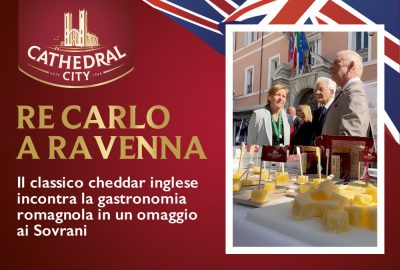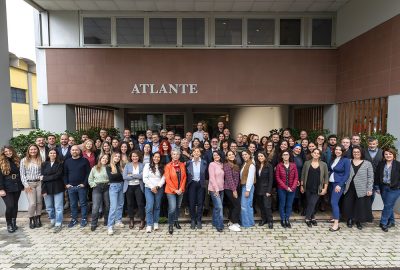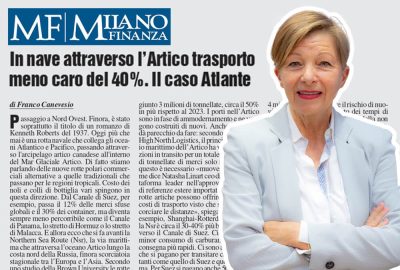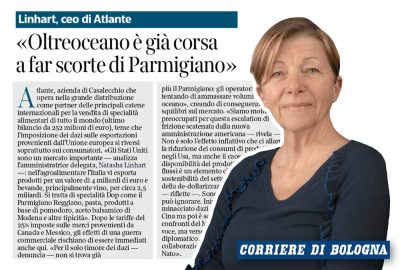Atlante
News
Italian chocolate conquers Switzerland – and there’s no sign of stopping

27 December 2023
According to a recent article by Sole 24 Ore, Italian chocolate is currently enjoying a golden moment in Switzerland and on the global stage. Exports have increased by 37% in four years, with a further increase in 2023. Atlante, having thoroughly analysed this phenomenon, highlights the growing interest in Italian chocolate and its steadily increasing popularity.
Natasha Linhart, the founder and CEO of Atlante, emphasises the significance of this trend in the Italian food sector and beyond. In fact, Atlante not only imports Frey’s Swiss chocolate to Italy, but also exports Italian chocolate to many countries around the world, from Great Britain to Japan. The company aims to reach €10 million with the Atlante Brand, a label reserved for authentic Italian-made products, in the next two years. The goal is to promote regional Italian chocolate traditions abroad, from Piedmont to Tuscany to Sicily.
Italian chocolate conquers Switzerland – and there’s no sign of stopping
Sales in Switzerland have increased by 37% in four years. This growth reflects a global trend: in the first eight months of 2023, exports were +5.6% compared to 2022, resulting in a positive balance of €994 million
by Manuela Soressi
24th December 2023
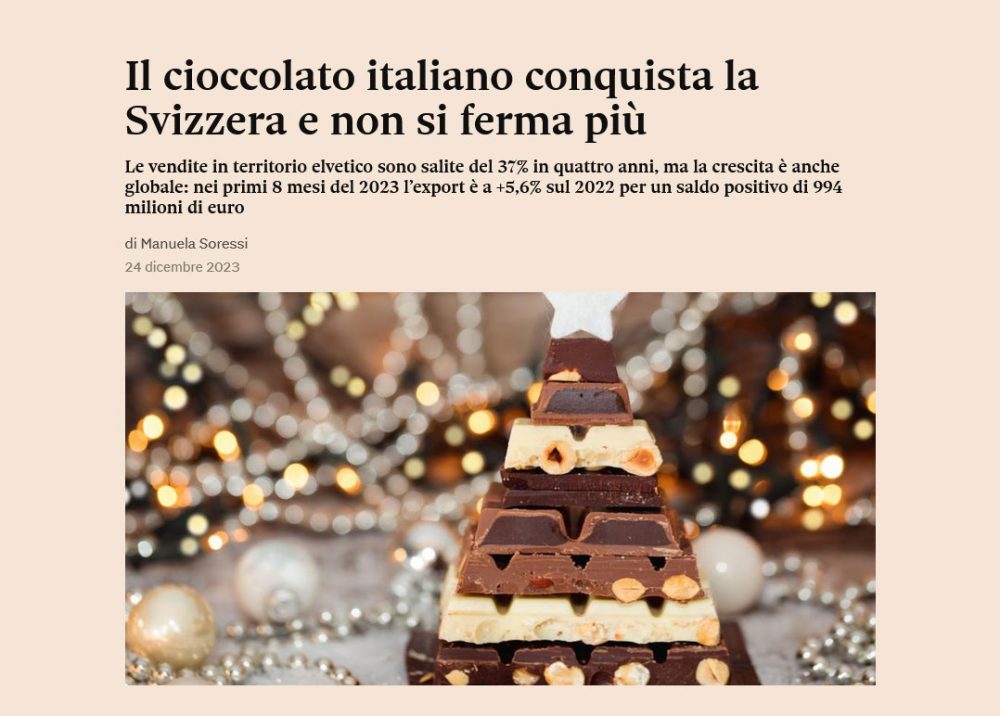
We are successfully selling chocolate to the Swiss, and the trend is on the rise. Between 2018 and 2022, exports to Switzerland increased by 37% in volume and 25% in value, reaching 3,386 tonnes and close to €29 million. This year, between January and October, there was an increase of 4.8% in volume and +5.8% in value, as reported by Chocosuisse, the producers’ federation. The same is not true of Swiss chocolate in Italy: over a ten-year period, we bought 16.4% less, for a total of 4,897 tonnes.
This trend is causing concern among Swiss manufacturers, who are contending with a domestic market that is yet to recover to pre-pandemic dimensions and is increasingly dominated by imported products due to the favourable quality/price ratio and low consumer loyalty to domestic brands.
Swiss manufacturers are showing a growing interest in Italian chocolate. Two years ago, the Lindt & Sprüngli Group took over the historic producer Caffarel, the inventor of gianduiotto. Nestlé also increasing its import of Italian chocolate. Florence Audoyer, managing director of confectionary at Nestlé Italy, confirms, “In 2023, our Perugina brand experienced a growth in volumes exported to Switzerland. This success is due both to the collaboration with retailers, which has increased our visibility, and to the constant investments in the San Sisto factory (€14 million in 2022-23) to establish it as the international chocolate hub and strengthen the export of iconic Italian products.”
The success of Italian chocolate extends globally, as confirmed by Ismea data: in 2022, exports reached 266 thousand tonnes for a total of €1,679 million – a remarkable achievement marked by double-digit annual growth. In the first eight months of this year, volumes remained stable while turnover rose by a further 9.5%. This trend confirms the health of the sector’s trade balance, which, in the first eight months of 2023, attained a positive balance of €994 million (+5.6% compared to the same period in 2022), solidifying Italy’s significant global role, with a 12% share of world chocolate exports.
Mario Piccialuti, Director-General of Unione Italiana Food, the association that brings together producers in Italy, explains, “What has consistently propelled Italian chocolate forward is not only the ability to select excellent raw materials and produce chocolate without any vegetable fats other than cocoa butter, but also an increasingly developed capacity for innovation. These factors position Italian companies as leaders worldwide. Additionally, there are iconic products such as Italian pralines, which act as ‘forerunners’ in challenging or less obvious markets, such as Switzerland.” Swiss consumers, in fact, love artisan pralines and chocolate truffles (with Turin-based company La Perla experiencing a 10% annual sales increase). This Christmas, for instance, an all-Italian chocolate bar by Amedei was selected by the Globus department store chain.
The influence of Italian chocolate is not limited to Switzerland. As the ‘Exporting La Dolce Vita’ report indicates, chocolate is a key product in Italian food exports to approximately twenty countries, including Saudi Arabia and Brazil. This internationalization is evident in the success of many companies. For instance, foreign sales contribute to 60% of Icam’s turnover, 50% for Venchi, 40% for Domori, Amedei, and Zàini, and over 80% for Sorini.”
“Italy has a long tradition in quality chocolate, particularly chocolate with hazelnuts. This expertise is globally recognised, especially in the premium segment,” emphasises Natasha Linhart, founder and CEO of Atlante, an import-export company based in Bologna with a chocolate turnover of €15 million. Atlante also imports Swiss Frey chocolate into Italy (1.7 million kg per year) and exports Italian chocolate to dozens of countries, from Japan to Great Britain. “The most popular products are gianduiotti and cremino-filled bars, which we also make in special versions for South Africa, for example with pomegranate kernels or orange peel,” Linhart adds. These products are marketed under the Atlante brand, reserved for authentic Made in Italy products, which currently boasts a turnover of €1 million. In the next two years, it aims to reach €10 million, driven by the acquisition of new customers in retail and the expansion of the product range. The focus is also on showcasing the regional tradition of Italian chocolate abroad, from Piedmont to Tuscany to Sicily.

